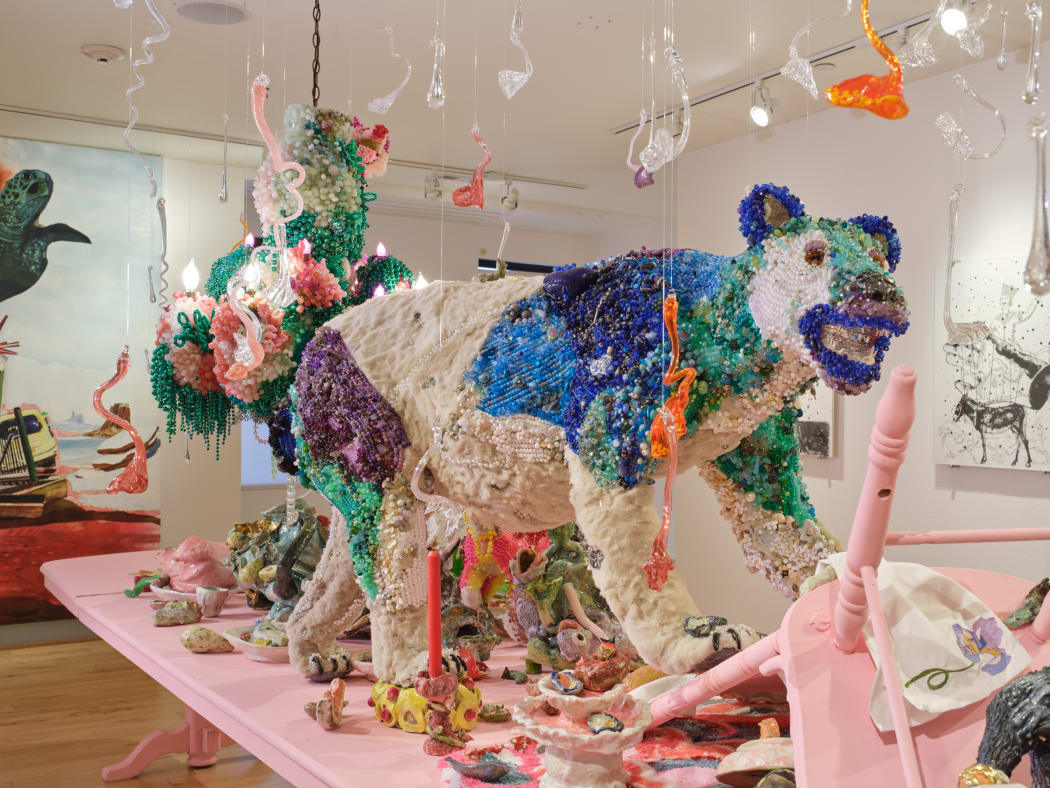
CURATORIAL STATEMENT
“A revolution is not a dinner party, or writing an essay, or painting a picture, or doing an embroidery. It cannot be so refined, so leisurely and gentle, so temperate...” -Mao Zedong
Chairman Mao’s statement is about shaping social and political change with an iron will; during China’s Cultural Revolution, he refused to wine and dine his detractors. Perhaps in the future, nature’s current revolt against humanity will seem just as swift and unflinching. The post-apocalyptic banquet of Jenny Day’s A Feast to Remember, with its misshapen menagerie of party crashers, swirls in an uncertain zone between dark contemporary allegory and dystopian speculative fiction, but humor and hopeful ingenuity are in the mix too.
Art history is bursting with revolutionary meals, from Da Vinci’s The Last Supper (1498) to Judy Chicago’s The Dinner Party (1974-79). I’d invite you to some lesser-known gatherings as an appetizer for Day’s visual feast. Swing by a tea party by David Gilhooly, the California Funk ceramicist who stacks idiosyncratic frogs between sculptural finger foods. Brunch with Liza Lou, whose life-size, hand-beaded Kitchen installation (1991-1996) critiques the commercial cacophany of the modern domestic sphere. Or perhaps you’d rather become the delicacy by tangling with Faith Wilding’s Crocheted Environment inside Womanhouse (1972), an immersive feminist exhibition organized by Chicago and Miriam Schapiro.
Gilhooly, Lou, Wilding and Day are all playing in a post-surrealist world—and if there’s anything that united the surrealists it was a dinner party. As a sculptural subject, food is robustly surreal, with its eerie power to both tempt and disgust us. There’s a memento mori built right into its expiration date. Meret Oppenheim folded this decadent-but-squicky feeling into a fur-lined teacup (1936), while Salvador Dali stirred it up with a lobster-crowned telephone (1938). E voilà—dreamy delight with a garlicky garnish of modern disorientation.
Day’s immersive installation, and her large-scale works that roam the other rooms of this exhibition, can be so overwhelming that you might have to look at them sideways at first. The Santa Fe-based artist loves to wander this peripheral space: for inspiration, she runs through the foothills of the Sandia Mountains at dusk until the rods of her retinas start to betray her, morphing landforms into melons, elephants or shipwrecks.
The sculptural forms of A Feast to Remember may appear wild or untidy, but it takes serious technical mastery to bring a flickering sensation—between our world and a dusky fugue state—into material reality. If you take your time to study individual objects on the tabletop, you’ll intuitively grasp the grueling experimentation that resolved ceramic glazes and glittering beads into cake frosting, bobcat fur and alligator skin. That’s where the hope comes in: just as flora and fauna are evolving to overtake the Anthropocene, perhaps we can imagine and invent our way into a far less human-centric world. And it’s also part of the joke: our seat at Earth’s table has been justly toppled.
-Jordan Eddy, Director

artist STATEMENT
A Feast to Remember investigates climate change with humor and caution. A site-specific installation depicting natural and personal disaster, new work includes acrylic on canvas paintings and various ceramic and mixed media light-emitting sculptures.
Central to A Feast to Remember is a ruined dinner party on an elongated pink dining table and several large paintings. Acrylic on canvas paintings portray habitats in turmoil, animals leaping in cautionary celebration. Visitors explore a chaotic version of The Last Supper, all ceramic and mixed media sculpture, whimsical and raucous. Surreal chandeliers and ceramic pendent lights are suspended from the ceiling at multiple heights. They are adorned with animals and dripping with beads.
On the table a feast; plates mounded with fruit, lobsters, oysters, smashed cakes, candy, an alligator, candelabras, a beaded bear sauntering across the chaos. Multitudes of ceramic rats and slugs. A hand-tufted rug beneath it all, a portal into a ravaged landscape, hot pink algae blooms and the aftermath of hurricanes.
The exhibition is celebratory in its joyful chaos—a final party abandoned, subsumed by biophilia, a cautionary disaster in the making. The installation examines our need for myth while incapsulating our relationship to land and the exploitation of the environment. The work is not just coping with the world but refashioning it. Toxic hues, broken objects and the remnants of a dinner party disturbed by chaos are a reflection of an external world gone awry. Anarchy amidst a kingdom in peril.
-Jenny Day